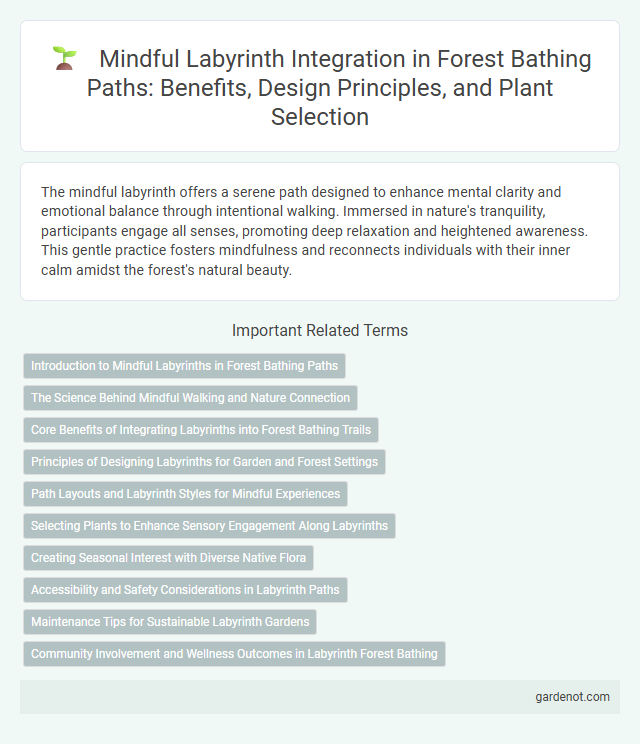The mindful labyrinth offers a serene path designed to enhance mental clarity and emotional balance through intentional walking. Immersed in nature's tranquility, participants engage all senses, promoting deep relaxation and heightened awareness. This gentle practice fosters mindfulness and reconnects individuals with their inner calm amidst the forest's natural beauty.
Introduction to Mindful Labyrinths in Forest Bathing Paths
Mindful labyrinths in forest bathing paths offer a unique way to deepen connection with nature through intentional walking and meditation. These intricate, circular designs encourage slow, deliberate movement, enhancing focus and emotional clarity while surrounded by the calming forest environment. Integrating mindful labyrinths into forest bathing paths amplifies stress reduction, promotes mental wellness, and fosters a heightened awareness of the present moment.
The Science Behind Mindful Walking and Nature Connection
Mindful labyrinth walking stimulates the parasympathetic nervous system, reducing cortisol levels and promoting relaxation through rhythmic, intentional movement. Neuroscientific studies show that immersive nature experiences enhance prefrontal cortex activity, improving emotional regulation and cognitive function. This therapeutic practice leverages biophilia to deepen the mind-body connection, fostering greater mindfulness and stress relief during forest bathing sessions.
Core Benefits of Integrating Labyrinths into Forest Bathing Trails
Integrating mindful labyrinths into forest bathing paths enhances mental clarity by promoting deep relaxation and focused meditation amid natural surroundings. The labyrinth's intricate design encourages mindfulness, reducing stress and improving emotional well-being through a meditative walking experience. This fusion supports cognitive restoration and greater self-awareness, enriching the holistic benefits of forest therapy.
Principles of Designing Labyrinths for Garden and Forest Settings
Mindful labyrinths are designed to promote meditation and presence within natural garden or forest environments by incorporating principles such as clear pathways, gentle curves, and a single, unambiguous route to the center and back. The layout encourages slow, intentional walking that fosters relaxation and connection with the surrounding nature. Integrating natural materials and considering local flora and terrain enhance the labyrinth's harmony with its environment, supporting a seamless sensory and spiritual experience.
Path Layouts and Labyrinth Styles for Mindful Experiences
Mindful labyrinth designs emphasize intricate path layouts that encourage slow, intentional walking, fostering deep meditation and stress reduction. Common labyrinth styles include the classical seven-circuit labyrinth, the Chartres labyrinth with eleven circuits, and unicursal patterns that guide contemplative focus without dead ends. These path configurations are strategically crafted to support mindfulness by promoting rhythmic breathing and sensory awareness throughout the forest bathing journey.
Selecting Plants to Enhance Sensory Engagement Along Labyrinths
Mindful labyrinth design integrates carefully selected plants to amplify sensory engagement, fostering deeper relaxation and presence. Aromatic herbs like lavender and rosemary stimulate olfactory senses, while textured foliage such as lamb's ear offers tactile interaction. Incorporating native wildflowers not only supports local biodiversity but also enriches visual appeal, enhancing the overall forest bathing experience.
Creating Seasonal Interest with Diverse Native Flora
A mindful labyrinth designed with diverse native flora enhances seasonal interest by showcasing a variety of textures, colors, and blooms throughout the year. Incorporating species such as flowering dogwood, cardinal flower, and switchgrass creates dynamic visual and sensory experiences that evolve with each season. This intentional planting supports local ecosystems while inviting visitors to engage deeply with nature's rhythms.
Accessibility and Safety Considerations in Labyrinth Paths
Mindful labyrinth paths designed for forest bathing prioritize accessibility by incorporating smooth, even surfaces and gentle gradients suitable for wheelchairs and walkers. Safety considerations include clear signage, non-slip materials, and adequate lighting to prevent trips and falls while ensuring users can navigate the path confidently. These design elements foster an inclusive, secure environment that enhances the therapeutic experience for all visitors.
Maintenance Tips for Sustainable Labyrinth Gardens
Regular pruning and debris clearance ensure clear pathways and vibrant plant health in mindful labyrinth gardens. Applying organic mulch conserves soil moisture and suppresses weeds, promoting sustainable growth. Periodic inspection of boundary markers or stones prevents erosion and maintains the labyrinth's intended structure and flow.
Community Involvement and Wellness Outcomes in Labyrinth Forest Bathing
Mindful labyrinths in forest bathing paths foster community involvement by encouraging group participation and shared reflective experiences, enhancing social cohesion and collective mindfulness. Engaging in these labyrinth walks supports wellness outcomes such as reduced stress, improved mental clarity, and emotional balance through immersive nature-based meditation. Studies show that community-led labyrinth activities increase accessibility and promote sustained health benefits across diverse populations.
Mindful labyrinth Infographic

 gardenot.com
gardenot.com